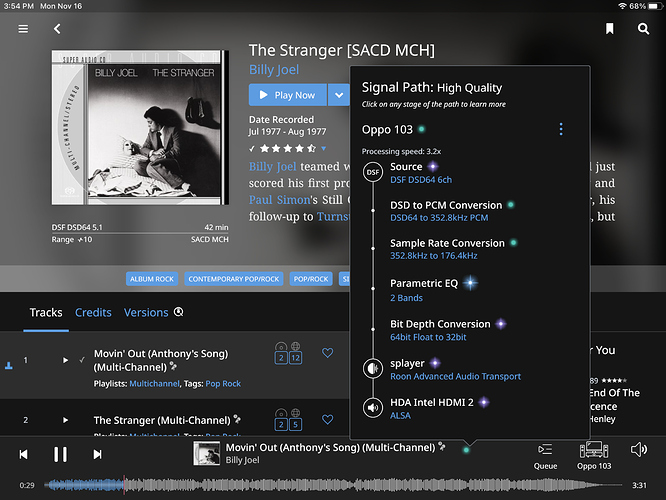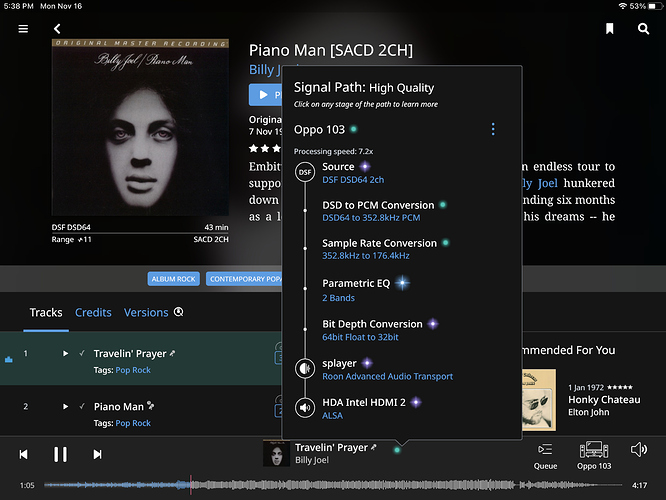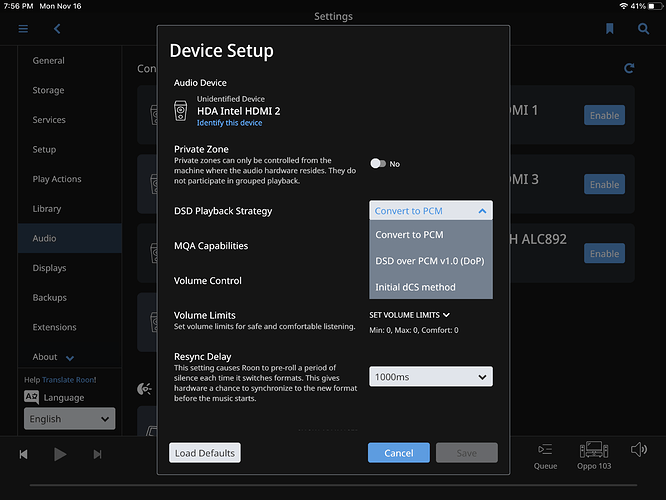From the Nucleus White paper -
Are there real—as in noticeable—SQ or performance diffs on ROCK and Roon Core between i3, i5 and i7?
I probably should trade my Nucleus for a Nucleus -. I have 39 tracks, play to one zone, and do no DSD.
Use case really dictates how much processing power is needed. Also, keep in mind one’s use may change over time.
For example, I first started using Roon in 2016; it came installed on the Salkstream III I purchased then (it has an i5 processor). At that time, I only had a local library of CDs I ripped (about 700 albums ripped to FLAC). Processing speed at that time was never an issue (always above 100x).
Fast forward to now, I’ve added Qobuz, multichannel SACD/DVD-A/PCM files, and started using Roon’s PEQ. This has dramatically changed the load on the processor. If I play a multichannel SACD file, streaming to one endpoint, processing speed drops to 3.2x as seen here;
In my case I think I might be in trouble if I had an i3 processor.
My recommendation is to go for more power than you expect to use now to give you room to grow, and to accommodate future advances in Roon that may require more hp (it has certainly advanced quite bit since I signed up in 2016).
And that’s why I want to benchmark the performance to see what performance could be extracted.
Plus prove that the latest and greatest quad-core i7 processor was not required to run Roon for the average normal user, with a library of less than 250,000 tracks and 10 zones.
Remember the single core performance of an Intel processor has not changed between NUC5 to NUC8, and only in NUC10 as they enabled Turbo boosting to the clock speed. ROCK is an embedded headless Linux-based OS, stripped of drivers, no GPU requirements, no WiFi or Bluetooth connectivity and isn’t power hungry.
So why spend on the latest gen i5 or i7 units, just to generate more heat that has to be cooled?
This is not your typical example - multichannel DSD with a DSP requirement to PCM  Plus ROCK will still play at 3.2x processing speed.
Plus ROCK will still play at 3.2x processing speed.
That’s 3x the number of channels most people use with Roon.
For comparison, please repeat with a 2-channel DSD recording?
My point was at the time I started with Roon, I didn’t know I would later be using files and features that required more hp. I’m glad it turned out that I had enough “headroom” to accommodate my more demanding uses today.
Here’s a 2ch SACD example for you. 
Fair point, but doesn’t the Oppo 103 support native DSD? Perhaps that’s only via the USB input? I don’t have one to test…just curious.
Good question.
My streamer is connected to the Oppo via HDMI for multichannel music listening. USB on the Oppo 103 only can be used for reading music files on USB sticks/drives, not audio streamed from another device. The Oppo then is connected to my Anthem AVM20 pre/pro (lacks HDMI) via multichannel analog. I’ve never tried sending DSD to the Oppo via HDMI. I’ll have to check that out. Originally, before hooking up the Oppo for multichannel, I had Roon set to convert DSD to PCM since my pre/pro doesn’t accept DSD. It didn’t occur to me to do any different with the Oppo. 
My streamer is also connected to my Anthem AVM20 pre/pro via optical spdif for 2 channel and AirPlay (streamer offers AirPlay as well which my spouse uses exclusively for Apple Music). Of course I can’t send DSD via that connection.
EDIT:
So which of these settings would be correct to send DSD to the Oppo via HDMI?
Try DoP this packages the DSD in a PCM container for the DAC/Network Player to process
I gave the other settings a try, but it only works if I set Roon to convert DSD to PCM.
It’s been quite some time since I set multichannel up, so maybe back then I knew the Oppo didn’t accept DSD via HDMI and forgot. 
My apologies to the OP for the thread sidetrack.
I don’t see many reasons to convert from PCM to DSD unless your DAC is native DSD and cheap. A much more meaningful core processing power hungry task is using convolution filters for hi res files in Roon DSP. An adequate corrective impulse response for 192 Khz Flac file contains over a million taps and pushes my i5 NUC to its very limits quickly. If you only use parametric equalizers than you’ll be fine but you will not have any phase correction which makes huge difference in SQ.
Just for clarity, we were discussing converting DSD files to PCM for compatibility. 
Ok, I see-thanks for the correction. I do that conversion, too since I cannot use convolution filters with DSD files and that really requires a powerful processor!
Btw, if you don’t mind me asking, is your name Turkish? I lived in Ankara 1970-1975 (father was in US Air Force).
Yes I was born and raised in Istanbul (and father was in Turkish air force!)
Cool! I still have relatives in Istanbul (I’m 1/2 Turkish).


